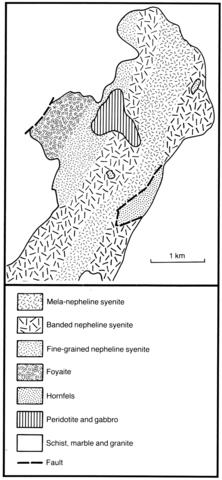stripes
The alkaline complex of Pestraya forms a steep-sided body that has an area of about 10 km2 and is elongated in an approximately north-south direction. The intrusion cuts granite and granodiorite of Proterozoic and upper Cambrian age, as well as upper Cambrian and Devonian pyroxenite, peridotite, gabbro-pyroxenite and diorite. The intrusion consists of various types of nepheline syenite which are distributed in a distinct banded structure. Various types of miaskitic nepheline syenite and medium-grained foyaite alternate with each other from east of west. The composition of the nepheline syenites varies slightly. The foyaites contain microcline-perthite, nepheline, albite and hastingsite with lesser amounts of lepidomelane, garnet, fluorite, titanite, apatite, Fe-Ti oxide minerals and sulphides. In the miaskitic nepheline syenites the prevailing dark-coloured mineral is lepidomelane and there is more albite than in the foyaites. The banded structure of the miaskites is mainly determined by variations of grain sizes and sometimes of composition. The widest bands (2-10 m) are composed of coarse-grained nepheline syenite containing the hackmanite variety of sodalite.
ANDREEVA, E.D. 1968. Alkaline magmatism of Kuznetsk Alatau. Nauka, Moscow. 169 pp.
KORTUSOV, M.P. 1963a. Nepheline syenite of the upper reaches of the Toydona River (the Pestraya Mt.) In I.K. Bazenov and Yu.D. Skobelev (eds) The geology and petrography of nepheline rocks of Kuznetsk Alatau. 151-60. Gosgeoltekhizdat, Moscow.

